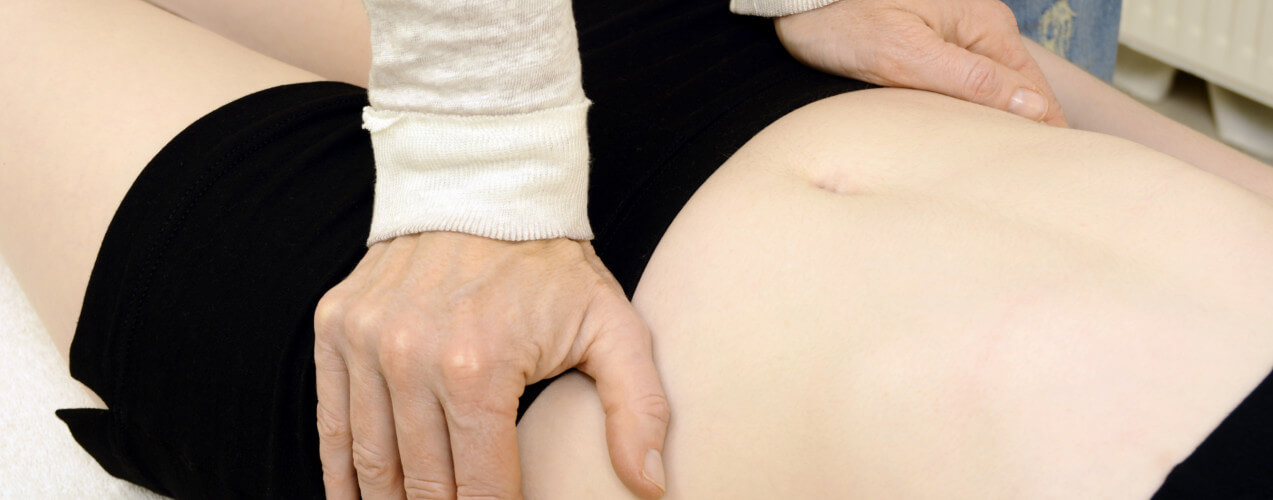Wellbridge Physical Therapy specializes in Women’s Health. Pelvic floor physical therapy includes the evaluation and treatment of women with the following diagnoses: pregnancy and postpartum conditions, urinary incontinence, over active bladder (OAB), constipation, pelvic pain, endometriosis, vaginismus, dyspareunia, IC, vulvardynia, pelvic organ prolapse, pudendal neuraligia, diastasis recti, infertility and more. Patients can expect to have an initial examination with a thorough look at the history of the condition and patient’s past and present health. External treatment will be applied such as exercises, massage, pelvic floor exercise, pelvic floor down training and core strengthening. Depending on the case, internal techniques could also be used to help treat pelvic floor conditions. Once assessed by the physical therapist, they will create an individualized plan of care to treat the pelvic floor condition and alleviate symptoms that the patient might be experiencing.
What to expect:
Your very first visit: The Evaluation
Walking into the Clinic:
- You will come in and check in with the front desk. There is some paperwork and forms that need to be filled out.
In the Examination Room:
- Your therapist will introduce herself. Initially there will be a short chat to get a history and learn all the information she will need to know regarding the reason for your visit.
- This can include, depending on reason for attending; your drinking and eating habits, your pain levels during different activities such as using a tampon or intercourse, or even counting how many times you go to the bathroom in a day.
- Try to be as detailed in your history as possible.
- Then moving onto the evaluation. This involves moving around and doing our testing or measurements to determine if your back, hips, or core are playing a role.
- Sometimes core weakness and low back/hip pain are associated with pelvic floor muscle dysfunction. There is a correlation.
The Orthopedic Exam:
- The therapist will run through the muscles and joints in your hips and back which can tell the therapist a lot about your body and what brought you into the clinic.
- Typically, this involves going into seeing how you move with range of motion, flexibility testing, and looking into your strength with manual muscle testing.
Prior to doing an Internal Examination:
- Your therapist will explain a little bit about pelvic floor therapy and how we treat pelvic floor dysfunction.
- Consent Form: There will be a form provided from the clinic explaining your options for the internal visit.
- You will provide the second person: saying that you would bring another person to sit in the room during the internal examination if that option makes you more comfortable.
- The clinic will provide the second person: The clinic would find another provider or worker at the clinic to sit in during the exam.
- You declining to have a second person present: It would be just you and your therapist in the room.
- Declining the internal exam: If you don’t feel comfortable with an internal exam, it can be declined and/or delayed. Without an internal exam, your therapist would make an educated guess about what is causing your pelvic floor issues. You will be given tips and exercises to help you achieve your goals without an internal examination.
- The therapist will set up the table with sheets and step out of the room for you to change. You would be undressed from the waist down and cover yourself with the sheets.
The Internal Examination:
- The therapist might start with an observation of a kegel, a cough, and bearing down.
- Kegel: Squeezing your vaginal muscles as if you were to stop the flow of urine.
- Bearing down: Pushing out like you were going to pass gas.
- Then she might palpate (feel) externally to see if there are any tight spots, like a knot in a muscle.
- Then if agreed by the patient, the therapist using a glove and lubricant will use their finger to internally assess the muscles and ask you to kegel again to determine your strength, endurance and overall pelvic floor control.
- Based on the findings of the internal examination, the therapist will explain the findings and how it relates to your issues. You will also be given very specific exercises or stretches to do.
- The therapist will step out and have you get ready.
Why do we do an Internal Examination?:
- What most women don’t know is that you have 3 layers of your pelvic floor.
- Doing the internal examination provides details about specific tight or weak muscles causing issues related to your concerns.
- If you have previously chosen to decline the pelvic internal examination, make sure you are very detailed with your therapist as to your symptoms. We can still provide you with excellent care based on your symptoms.
Your Plan of Care:
- After your therapist examines everything, they will go into detail about what they found during the evaluation to make sure you are aware and fully informed as to your findings and what the therapist can do to help.
- Your specific frequency of visits in how many times a week and for how long depends upon your therapist and the findings. Sometimes there only needs to be a few visits spread out to teach techniques and sometimes it can be a little more involved and hands on requiring more frequent visits.
- Your therapist will send you home with some exercises to help you progress towards the goals that you will set together in the clinic.
- Depending on your evaluation, you might be doing stretches for your hips, strengthening your core and hips, hands on manual stretching, kegels or reverse kegels, or all of the above.
Think you might need Pelvic PT?:
- There are several diagnoses or issues that might require or benefit from the assistance of pelvic physical therapy. Some include but are not restricted to:
- Dyspareunia, vulvodynia, vaginismus, pelvic inflammatory disease, lichens sclerosus, pudendal neuralgia, vulvar vestibulitis, stress incontinence, urge incontinence, mixed incontinence, interstitial cystitis, irritable bowel syndrome, constipation, coccydynia, Postpartum, Pain during pregnancy, and more.
- Not sure exactly if you would benefit from pelvic PT? Give us a call. We can always answer your questions.





